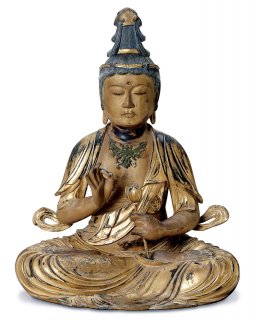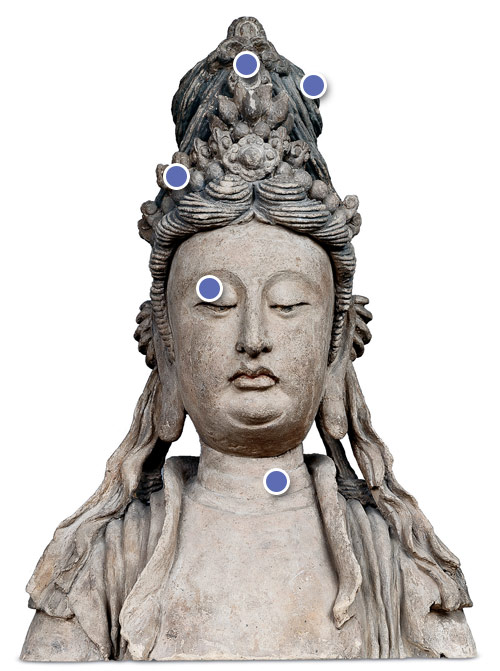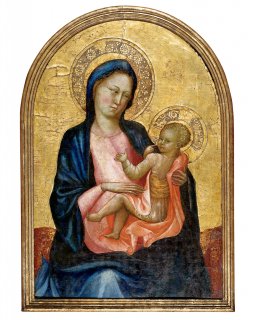
Chinese
Head of Guanyin
Clay mixed with straw with traces of pigment Height: 25 inches Museum purchase with funds provided by Mrs. Harrie G. Carnell 1959.41
Mercy!
Think of someone who was very kind to you. What did she or he look like? Look closer at this clay sculpture of Guanyin, a beloved figure of mercy in Buddhism, and see another face of compassion.
A Day in the Life
Gender Neutral
Guanyin is the Chinese name of Bodhisattva Avalokiteshvara, one of the most popular figures in Buddhism. (A bodhisattva is a spiritually advanced being who has postponed becoming a Buddha in order to save others and help them achieve enlightenment.) This popularity can be traced back to The Lotus Sutra, a central Buddhist scripture. Chapter 25 describes Avalokiteshvara—whose name means “Perceiver of the World’s Sounds”—as a compassionate figure who will immediately hear the cries of all who call its name and deliver them from their suffering.
Does this sculpture look female? Male? Androgynous? Avalokiteshvara’s power and dedication to helping others is so strong that it may take any form necessary to save a particular individual. As a result, visual depictions of Avalokiteshvara vary, especially in gender. The Lotus Sutra argues that all beings have inherent Buddha nature, so women can pursue Buddhahood as well as men. And when it lists 33 different forms Avalokiteshvara can take, these include female forms, such as a nun, a laywoman, a wife, or a young girl.
In contrast, this Guanyin from China which may appear more feminine, while the nearby Kannon Bosatsu (the Japanese name of Avalokiteshvara) in Gallery 107 may appear more masculine, including having a mustache. Consider how these different ways of depicting gender in the same figure compare with other ways you have seen gender represented in art.

Japanese, Kannon Bosatsu (Avalokiteshvara), 15th–16th century, wood with lacquer, gilding, pigments, copper, crystal, and beads, 17 ½ x 13 inches. Museum purchase with funds provided by Virginia Rike Haswell, 1979.49.
Tools and Techniques
Behind the Scenes
Look Closer
A New Point of View
This ceramic sculpture of Guanyin was painted. It still retains some of the original pigment—look for some of the remaining coloration in the hair and eyes. Also, this head was originally part of a larger sculpture and would have sat higher than eye level. Kneel down and look up at the face and consider how this changes your impression of the figure.
Poll
Which perspective do you find more interesting?
Just for Kids
Imagine!
Imagine traveling back in time to China. This sculpture of Guanyin, a figure of mercy in Buddhism, would have been painted and part of a larger sculpture. Think about how it would have felt to stand in front of it then.
How do you think Guanyin’s body was posed? Using clay, try to closely recreate the Head of Guanyin and include how you imagine the body looked.
Signs & Symbols
Rich with Meaning
How do we know this is a bodhisattva and not the historical Buddha? Tap on the different parts of the sculpture to find out.

Additional Information: Further reading: Meher McArthur, Reading Buddhist Art: An Illustrated Guide to Buddhist Signs and Symbols (London: Thames & Hudson, 2002).
Dig Deeper
Arts Intersected
The Sculpture Speaks
Did You Know?
Expert Opinion
Look Around
Different Faces of Compassion
Guanyin is infinitely compassionate and concerned with all who are suffering. In East Asia, the depiction of Guanyin as a female emphasized her motherly love and she was associated with childbearing. In these ways, Guanyin shares certain similarities with the Virgin Mary. Compare this sculpture of Guanyin with Giovanni Francesco Toscani’s Madonna of Humility in the European Galleries. The two works are made with different materials, during different times, in different places, and based on different faith traditions, but consider their similarities.

Giovanni Francesco Toscani (Italian, 1370–1430), Madonna of Humility, c. 1410, tempera and gold leaf on poplar, 26 ¾ x 18 ¼ inches. Gift of Mr. and Mrs. Elton F. MacDonald 1957.142.
About the Artist
Talk Back
Feeling Great
This sculpture is technically accomplished, but it is also rich with emotion. How may the feelings generated by a work of art contribute to determining its overall quality? Is a work less of a masterpiece if it does not touch the heart’s strings?

